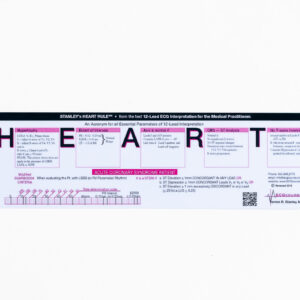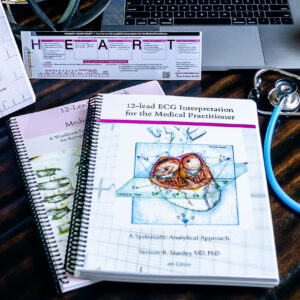(C) 2024 Renewed ECGcourse.com. All rights reserved. | Vernon R. Stanley, MD, PhD, Author | Courtney Stanley, MS, PA-C, Editor
In a previous post, we discussed the RBBB and Primary T-wave changes to help detect changes of the acute STEMI. The LBBB poses additional difficulty in detecting the acute STEMI. Common changes & distortions to the 12-lead ECG secondary to presence of the LBBB include distortions such as: ST elevations and T-wave changes & widened QRS complexes with appearance of “significant Q-waves”.
Before proceeding to this blog post, please answer the following ECG Challenge questions. The answers are listed at the bottom of this blog.
Question 1: True or False – The electrical axis of the LBBB is always a Left Axis Deviation (LAD).
Question 2: The QRS duration in a Left Bundle Branch Block (LBBB) is:
- A. > 0.10 seconds
- B. > 0.12 seconds
- C. > 0.01 seconds
Question 3: In a Left Bundle Branch Block (LBBB), Lead I is all ______ (slur or notch).
- A. Inverted
- B. Biphasic
- C. Upright
Educator Resources | Compare All Courses
You have been requested to interpret the 12-lead ECG tracing below with a particular focus of uncovering acute myocardial ischemia/infarction (STEMI).

INTERPRETATION of this 12-lead ECG Above
- LBBB (Left Bundle Branch Block) with Primary T-waves noted. The presence of Primary T-waves is sometimes suspicious of myocardial disease.
- ST-T changes Leads V1, V2 probably pseudo-infarction changes (cannot rule out ischemia /infarction).
- Clinical correlation recommended and comparison with old tracing.
TEACHING FOCUS OF THIS LESSON:
1. Review of the criteria of the classic LBBB (Left Bundle Branch Block).
2. Primary and Secondary T-wave changes of the LBBB.
3. Utilization of the computer interpretation.
The criteria of the classic LBBB (Left Bundle Branch Block) is as follows:
Triad of the LBBB
- | QRS | > or = 0.12 sec.
- Lead V6 or V5 or V4 RSR’ complex (slur or notch).
- Lead I is all upright with slur or notch.
Notice that this Case Study tracing does indeed satisfy the TRIAD of the LBBB.
SECONDARY AND PRIMARY T-WAVE CHANGES OF THE LBBB
Please scroll up to this Case Study tracing and note that I have circled, magnified and color-labeled Leads I, II and V6. In particular, notice the terminal portion of the QRS complex – each one of these areas is positive. Now notice the T-wave’s polarity, i.e. each of the T-waves is also POSITIVE (UPRIGHT).
This polarity of
POSITIVE—————————————–POSITIVE
NEGATIVE—————————————NEGATIVE
is described as PRIMARY T-WAVE changes or concordance of the QRS-T waves.
PRIMARY T-WAVES OF THE LBBB
The T-wave is directed in the same direction as the terminal portion of the QRS complex. For example
if the terminal portion of the QRS complex is POSITIVE….the T-wave is UPRIGHT (POSITIVE)
OR
If the terminal portion of the QRS complex is NEGATIVE…the T-wave is INVERTED (NEGATIVE).
These are described as PRIMARY T-WAVES or concordance of the QRS-T. This clinically is uncommon and indeed represents suspicion of myocardial disease such as myocardial ischemia. Primary T-waves basically represent a red flag and serve as a guide and warning to be even more diligent with your clinical correlation, cardiac markers and comparison with the old 12-Lead tracing.
SECONDARY T-WAVES OF THE LBBB
If the terminal portion of the QRS complex is POSITIVE…the T-wave is INVERTED (NEGATIVE).
If the terminal portion of the QRS complex is NEGATIVE…the T-wave is UPRIGHT (POSITIVE).
These QRS-T polarity correlations are called SECONDARY T-waves or discordance of the QRS-T. It is the most common finding in the LBBB and unlike the PRIMARY T-waves does NOT suggest ischemia/infarction.
PEARL regarding Primary T-waves and the Left Bundle Branch Block:
PRIMARY T-WAVES in the LBBB is an uncommon finding and is sometimes indicative of disease such as myocardial ischemia. The LBBB is the greatest booby trap of electrocardiography and its distortion of the waveform makes it extremely difficult to recognize ECG changes of the Acute MI or ischemia. Indeed, the changes observed are usually pseudoinfarction / ischemia changes, these common findings are as follows [Be aware of the diagnostic STEMI changes of the Sgarbossa Criteria]:
LEADS……………………….COMMON FINDINGS (usually pseudoinfarction /ischemia)
- V1, V2, V3………………….Significantly wide Q-waves
- V1, V2, V3………………….ST elevation concave down
- V1, V2, V3………………….Peaked T-waves
- I, avL, V6, V5, V4………..ST depression and/or T-wave inversion
REMEMBER: You can diagnose the acute STEMI if the ECG satisfies the Sgarbossa Criteria. We will revisit this phenomenon in a later posting.
SPECIAL NOTE on UTILIZATION OF THE COMPUTER INTERPRETATION
It is well agreed that the practitioner should not make treatment and disposition decisions based on the computer interpretation of the 12-Lead ECG. The computer often misinterprets, overreads and underreads. This is especially true in the area of ST-T analysis. My advice is simple:
The computer interpretation of the 12-lead ECG is valuable as a second opinion but the most important first opinion is that of the human brain ——– yours. The analysis of the ST-T changes of the cardiogram is fraught with mimics, masks, booby traps and pseudopatterns. The computer software is often unable to systematically defuse this mine field and may lead you to believe that the tracing is an acute MI (or not) with catastrophic results associated with the inappropriate treatment.
Please scroll back up to this Case Study tracing and notice I have placed an ellipse and magnified the text of the computer measurements. These measurements will serve as a quick reference, and the computer measurements on these are USUALLY CORRECT. You should especially establish the habit of noting the following measurements:
- Voltage criteria for Hypertrophy
- Ventricular Rate
- Durations
- PR interval
- | QRS |
- QT/QTc
- Axis
- QRS-ST analysis
- R-wave progression
- Transition Zone
Read More
- RBBB (Right Bundle Branch Block) & Primary T-wave Changes – ECGcourse.com
- A 12-lead ECG LBBB vs RBBB Mnemonic using HEART – ECGcourse.com
- Left Bundle Branch Block (LBBB) • LITFL • ECG Library Diagnosis
- STEMI in the Presence of LBBB | Emergency Physicians Monthly
- Rapid Diagnosis of STEMI Equivalent in Patients With Left Bundle‐Branch Block: Is It Feasible? | Journal of the American Heart Association
Question 1: True or False – The electrical axis of the LBBB is always a Left Axis Deviation (LAD).
Question 2: The QRS duration in a Left Bundle Branch Block (LBBB) is:
- A. > 0.10 seconds
- B. > 0.12 seconds
- C. > 0.01 seconds
Question 3: In a Left Bundle Branch Block (LBBB), Lead I is all ______ (slur or notch).
- A. Inverted
- B. Biphasic
- C. Upright
©2017, 2023, 2024 Renewed Vernon R. Stanley, MD, PhD. All Rights Reserved
-
Sale Product on sale
 HEART Ruler Mnemonic Pocket Guide
HEART Ruler Mnemonic Pocket Guide$15.00Original price was: $15.00.$9.95Current price is: $9.95. -
 12-lead ECG Interpretation Workbook$48.50
12-lead ECG Interpretation Workbook$48.50 -
Sale Product on sale
 12-lead Textbook, Workbook & HEART Ruler Packet
12-lead Textbook, Workbook & HEART Ruler Packet$132.00Original price was: $132.00.$115.00Current price is: $115.00. -
 50 ECG Case Studies Course (13 Hrs CME)$145.00
50 ECG Case Studies Course (13 Hrs CME)$145.00 -
Sale Product on sale
 50 ECG Case Study & STEMI Review Combo Pack (19 Hrs CME)
50 ECG Case Study & STEMI Review Combo Pack (19 Hrs CME)$235.00Original price was: $235.00.$199.00Current price is: $199.00. -
 Advanced 12-Lead ECG Interpretation Course (30 Hrs CME)$499.00
Advanced 12-Lead ECG Interpretation Course (30 Hrs CME)$499.00
